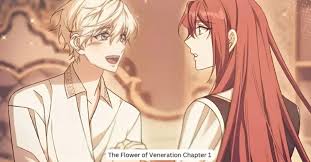
Introduction to the flower of veneration chapter 1
Welcome to the enchanting world of The Flower of Veneration Chapter 1. In this mystical journey, we delve into the rich history, symbolism, and cultivation of a flower that has captivated hearts and minds for centuries. Join us as we unravel the significance behind this revered bloom and discover why it continues to hold a special place in cultures around the globe. Let’s embark on this floral adventure together!
The History and Significance of the Flower
In the ancient annals of history, the flower of veneration has been revered across civilizations for its profound symbolism and significance. Its origins can be traced back to mystical tales and cultural legends that speak of its divine beauty and spiritual essence.
Through centuries, this sacred bloom has symbolized purity, enlightenment, and transcendence in various traditions around the world. Its delicate petals have inspired poets, artists, and mystics alike to ponder upon its mysterious allure.
From royal gardens to humble abodes, cultivating these flowers requires patience, skill, and a deep connection with nature. Carefully tended to with love and devotion, these blossoms flourish into stunning displays of grace and elegance.
As time passes by, the flower continues to weave its magic into modern societies through art installations, floral arrangements in weddings or ceremonies. Its timeless appeal persists as a symbol of reverence and admiration for the wonders of nature’s creations.
Symbolism and Meanings Associated with the Flower
The Flower of Veneration, in Chapter 1, carries deep symbolism and meanings that have transcended time. The intricate layers of its petals symbolize the complexities of life and personal growth.
In various cultures, this flower represents different virtues such as loyalty, resilience, and grace. Its vibrant colors mirror the spectrum of human emotions – from joy to sorrow. The delicate fragrance it emits evokes feelings of peace and tranquility.
When cultivated with care and attention to detail, this flower becomes a reflection of one’s inner self – blooming into a masterpiece that captivates all who behold it. Its presence in rituals and ceremonies signifies reverence for nature’s wonders and the cycle of life.
As we delve into the depths of its symbolism, we uncover layers of meaning that resonate with our souls on a profound level. The Flower of Veneration truly embodies the essence of beauty intertwined with spirituality like no other bloom can achieve.
Cultivation and Care Tips for Growing the Flower
When it comes to cultivating and caring for the Flower of Veneration, there are a few key tips to keep in mind. Ensure that the flower receives an adequate amount of sunlight daily but avoid exposing it to direct harsh sunlight for prolonged periods.
Additionally, make sure the soil is well-draining as this flower thrives in moist but not waterlogged conditions. Water the plant regularly, allowing the top layer of soil to dry out between watering sessions.
To encourage healthy growth and blooming, consider fertilizing with a balanced liquid fertilizer every two weeks during the growing season. Pruning dead or decaying parts of the plant will help promote new growth and maintain its overall health.
Be attentive to any signs of pests or diseases and address them promptly to prevent any damage to your beloved Flower of Veneration. With proper care and attention, this revered flower will flourish beautifully in your garden.
Uses of the Flower in Various Cultures and Traditions
The flower of veneration holds a special place in various cultures and traditions around the world. In ancient Egypt, the flower was used in ceremonies honoring gods and goddesses, symbolizing purity and rebirth.
In Japanese culture, this revered bloom is often featured in traditional tea ceremonies as a symbol of beauty and grace. It is also commonly used to decorate altars during religious festivals in India, representing devotion and spirituality.
Across different cultures, the significance of this sacred flower remains consistent – embodying qualities such as reverence, beauty, and spiritual connection. Its versatility in rituals and celebrations showcases its enduring appeal worldwide.
Modern Interpretations and Adaptations of the Flower
In modern times, the flower of veneration from Chapter 1 has found new interpretations and adaptations across various art forms. Artists have taken inspiration from its beauty and symbolism to create stunning paintings, sculptures, and even fashion designs. The intricate patterns of the flower have influenced contemporary graphic designers in creating captivating visuals.
Moreover, the flower’s rich history and significance have inspired writers to include it in their novels and poetry, adding layers of meaning to their works.
Furthermore, botanical experts continue to study this revered flower for its medicinal properties and environmental benefits. With sustainability at the forefront, many are exploring ways to cultivate this precious plant responsibly. Modern interpretations of the flower of veneration highlight its timeless appeal and enduring relevance in today’s society.
Conclusion: Why the Flower of Veneration Continues to Captivate Us Today
The Flower of Veneration Chapter 1 has stood the test of time, captivating us with its rich history, deep symbolism, and widespread significance across cultures. Its beauty transcends generations, making it a timeless symbol of admiration and respect. Whether used in ceremonies, art, or personal gardens, this flower continues to evoke feelings of veneration and reverence.
Its ability to connect us to our roots and inspire awe showcases why this flower remains beloved by so many. As we strive for meaning and connection in our lives, the Flower of Veneration Chapter 1 serves as a poignant reminder of the power that nature holds over our hearts and minds.
So next time you encounter this majestic bloom, take a moment to reflect on its history, meanings, and care tips. Let it remind you of the importance of honoring traditions while embracing growth and adaptation. The Flower of Veneration Chapter 1 is more than just a flower—it is a symbol of veneration that continues to captivate us today with its timeless allure.